Genetic Diversity and Phylogenetic Analysis of Zygophyllum loczyi in Northwest China’s Deserts Based on the Resequencing of the Genome
Abstract
:1. Introduction
2. Materials and Methods
2.1. Sampling and DNA Extraction
2.2. Determination of DNA Content by Flow Cytometry
2.3. Genome Resequencing, Assembly, and Annotation
2.4. SNP and Variant Detection and Annotation
2.5. Genetic Evolution Analysis
3. Results
3.1. Quality Control of Sequencing Data
3.1.1. Genome Size and Sequencing
3.1.2. Analysis of Base Sequencing Quality Distribution
3.1.3. Analysis of Reference Genome Comparisons
3.1.4. SNP Identification and Quality Control
3.1.5. Detection and Distribution of Variation
3.1.6. Genomic Signals of Adaptation
3.2. Genetic Evolution Analysis
3.2.1. Genetic Diversity
3.2.2. Phylogenetic and Population Genomic Analyses
3.2.3. Linkage Disequilibrium Decay Analysis
4. Discussion
5. Conclusions
Supplementary Materials
Author Contributions
Funding
Institutional Review Board Statement
Informed Consent Statement
Data Availability Statement
Acknowledgments
Conflicts of Interest
References
- Dlugosch, K.M.; Parker, I.M. Founding events in species invasions: Genetic variation, adaptive evolution, and the role of multiple introductions. Mol. Ecol. 2008, 17, 431–449. [Google Scholar] [CrossRef] [PubMed]
- Reed, D.H.; Frankham, R. Correlation between fitness and genetic diversity. Conserv. Biol. 2003, 17, 230–237. [Google Scholar] [CrossRef]
- Gentili, R.; Solari, A.; Diekmann, M.; Dupre, C.; Monti, G.S.; Armiraglio, S.; Assini, S.; Citterio, S. Genetic differentiation, local adaptation and phenotypic plasticity in fragmented populations of a rare forest herb. PeerJ. 2018, 6, e4929. [Google Scholar] [CrossRef] [PubMed]
- Kawecki, T.J.; Ebert, D. Conceptual issues in local adaptation. Ecol. Lett. 2004, 7, 1225–1241. [Google Scholar] [CrossRef]
- Leinonen, T.; McCairns, R.J.S.; O’ Hara, R.B.; Merila, J. Q(ST)-F-ST comparisons: Evolutionary and ecological insights from genomic heterogeneity. Nat. Rev. Genet. 2013, 14, 179–190. [Google Scholar] [CrossRef] [PubMed]
- Mace, E.S.; Tai, S.S.; Gilding, E.K.; Li, Y.H.; Prentis, P.J.; Bian, L.L.; Campbell, B.C.; Hu, W.S.; Innes, D.J.; Han, X.L.; et al. Whole-genome sequencing reveals untapped genetic potential in Africa’s indigenous cereal crop sorghum. Nat. Commun. 2013, 4, 2320. [Google Scholar] [CrossRef] [PubMed]
- William, J.W.T.; Yueqi, Z.; Junrey, C.A.; Aldrin, Y.C.; Jaco, D.Z.; Samantha, L.H.; Jacqueline, B. Innovative Advances in Plant Genotyping. Plant Genotyping 2023, 2638, 451–465. [Google Scholar] [CrossRef]
- Sakhale, S.A.; Yadav, S.; Clark, L.V.; Lipka, A.E.; Kumar, A.; Sacks, E.J. Genome-wide association analysis for emergence of deeply sown rice (Oryza sativa) reveals novel aus-specific phytohormone candidate genes for adaptation to dry-direct seeding in the field. Front. Plant Sci. 2023, 14, 1172816. [Google Scholar] [CrossRef]
- Gupta, A.; Rico-Medina, A.; Cano-Delgado, A.I. The physiology of plant responses to drought. Science 2020, 368, 266–269. [Google Scholar] [CrossRef]
- Qian, C.J.; Yan, X.; Fang, T.Z.; Yin, X.Y.; Zhou, S.S.; Fan, X.K.; Chang, Y.X.; Ma, X.F. Genomic Adaptive Evolution of Sand Rice (Agriophyllum squarrosum) and Its Implications for Desert Ecosystem Restoration. Front. Genet. 2021, 12, 656061. [Google Scholar] [CrossRef]
- McCormack, J.E.; Hird, S.M.; Zellmer, A.J.; Carstens, B.C.; Brumfield, R.T. Applications of next-generation sequencing to phylogeography and phylogenetics. Mol. Phylogenet. Evol. 2013, 66, 526–538. [Google Scholar] [CrossRef]
- Savi, T.; Bertuzzi, S.; Branca, S.; Tretiach, M.; Nardini, A. Drought-induced xylem cavitation and hydraulic deterioration: Risk factors for urban trees under climate change? New Phytol. 2015, 205, 1106–1116. [Google Scholar] [CrossRef] [PubMed]
- Luhar, I.; Luhar, S.; Savva, P.; Theodosiou, A.; Petrou, M.F.; Nicolaides, D. Light Transmitting Concrete: A Review. Buildings 2021, 11, 480. [Google Scholar] [CrossRef]
- Wang, J.; Wang, K.L.; Zhang, M.Y.; Zhang, C.H. Impacts of climate change and human activities on vegetation cover in hilly southern China. Ecol. Eng. 2015, 81, 451–461. [Google Scholar] [CrossRef]
- Bally, J.; Nakasugi, K.; Jia, F.Z.; Jung, H.T.; Ho, S.Y.W.; Wong, M.; Paul, C.M.; Naim, F.; Wood, C.C.; Crowhurst, R.N.; et al. The extremophile Nicotiana benthamiana has traded viral defence for early vigour. Nat. Plants 2015, 1, 15165. [Google Scholar] [CrossRef] [PubMed]
- Varshney, R.K.; Shi, C.C.; Thudi, M.; Mariac, C.; Wallace, J.; Qi, P.; Zhang, H.; Zhao, Y.S.; Wang, X.Y.; Rathore, A.; et al. Pearl millet genome sequence provides a resource to improve agronomic traits in arid environments. Nat. Biotechnol. 2017, 35, 969–976. [Google Scholar] [CrossRef] [PubMed]
- Yang, F.L.; Zhou, Z.Y.; Zhang, N.; Liu, N.; Ni, B. Stress field modeling of northwestern South China Sea since 5.3 Ma and its tectonic significance. Acta Oceanol. Sin. 2013, 32, 31–39. [Google Scholar] [CrossRef]
- Song, M.C.; Yi, P.H.; Xu, J.X.; Cui, S.X.; Shen, K.; Jiang, H.L.; Yuan, W.H.; Wang, H.J. A step metallogenetic model for gold deposits in the northwestern Shandong Peninsula, China. Sci. China Earth Sci. 2012, 55, 940–948. [Google Scholar] [CrossRef]
- Xu, H.J. Variations of Vegetation and Its Influence Factors in the Arid Region of the Central Asia from 2000 to 2012. Master’s Thesis, Lanzhou University, Lanzhou, China, 2014; p. 5. [Google Scholar]
- Zhang, M.L.; Fritsch, P.W. Evolutionary response of Caragana (Fabaceae) to Qinghai-Tibetan Plateau uplift and Asian interior aridification. Plant Syst. Evol. 2010, 288, 191–199. [Google Scholar] [CrossRef]
- Liu, Y.X. A study on origin and formation of the Chinese desert floras. Acta Phytotaxon. Sin. 1995, 2, 131–143, (In Chinese with English Abstract). [Google Scholar]
- Ragab, R.; Prudhomme, C. Climate change and water resources management in arid and semi-arid regions: Prospective and challenges for the 21st century. Biosyst. Eng. 2002, 81, 3–34. [Google Scholar] [CrossRef]
- Ewing, S.A.; Sutter, B.; Owen, J.; Nishiizumi, K.; Sharp, W.; Cliff, S.S.; Perry, K.; Dietrich, W.; McKay, C.P.; Amundson, R. A threshold in soil formation at Earth’s arid-hyperarid transition. Geochim. Cosmochim. Acta 2006, 70, 5293–5322. [Google Scholar] [CrossRef]
- Tapponnier, P.; Xu, Z.Q.; Roger, F.; Meyer, B.; Arnaud, N.; Wittlinger, G.; Yang, J.S. Geology—Oblique stepwise rise and growth of the Tibet plateau. Science 2001, 294, 1671–1677. [Google Scholar] [CrossRef] [PubMed]
- An, Z.S.; Kutzbach, J.E.; Prell, W.L.; Porter, S.C. Evolution of Asian monsoons and phased uplift of the Himalayan Tibetan plateau since Late Miocene times. Nature 2001, 411, 62–66. [Google Scholar] [CrossRef]
- Huang, R.; Zhang, Y.; Shi, X.; Sun, Y.W. Middleand Late Permian Floras from the Eastern Junggar Basin, Xinjiang and Their Geological Implications. J. Jilin Univ. 2023, 53, 403–417. [Google Scholar]
- Kong, X.J.; An, S.Z.; Liu, H.M. Flora of Desert Seed Plants in the Northern and Southern Margin of Junggar Basin. Xinjiang Agric. Sci. 2019, 56, 457–464, (In Chinese with English Abstract). [Google Scholar]
- Ma, Y.; Liu, R.; Li, Z.; Jin, J.; Zou, X.; Tan, D.; Tao, T. Holocene environmental evolution recorded by sedimentation on the southern edge of the Gurbantunggut Deser. Arid. Land. Geogr. 2023, 1–20, (In Chinese with English Abstract). [Google Scholar]
- Chen, H.Z.; Jin, J.; Dong, G.R. Holocene Evolution Processes of Gurbantunggut Desert and Climatic Changes. J. Desert Res. 2001, 21, 333–339, (In Chinese with English Abstract). [Google Scholar]
- Chang, J.; Qiu, N.S.; Xu, W. Thermal regime of the Tarim Basin, Northwest China: A review. Int. Geol. Rev. 2017, 59, 45–61. [Google Scholar] [CrossRef]
- Yin, A.; Dang, Y.Q.; Zhang, M.; Chen, X.H.; McRivette, M.W. Cenozoic tectonic evolution of the Qaidam basin and its surrounding regions (Part 3): Structural geology, sedimentation, and regional tectonic reconstruction. Geol. Soc. Am. Bull. 2008, 120, 847–876. [Google Scholar] [CrossRef]
- Cheng, F.; Jolivet, M.; Guo, Z.J.; Wang, L.; Zhang, C.H.; Li, X.Z. Cenozoic evolution of the Qaidam basin and implications for the growth of the northern Tibetan plateau: A review. Earth Sci. Rev. 2021, 220, 103730. [Google Scholar] [CrossRef]
- Kurschner, H. Phytosociological studies in the Alashan Gobi—A contribution to the flora and vegetation of Inner Mongolia (NW China). Phytocoenologia 2004, 34, 169–224. [Google Scholar] [CrossRef]
- Ren, J.; Tao, L. Quantitative Studies on Floristic Similarity of Rare and Endangered Desert Plants in China. Arid. Zone Resour. Environ. 2002, 16, 103–107, (In Chinese with English Abstract). [Google Scholar]
- Zhang, Y.Y.; Zhang, W.W.; Manzoor, M.A.; Sabir, I.A.; Zhang, P.F.; Cao, Y.P.; Song, C. Differential involvement of WRKY genes in abiotic stress tolerance of Dendrobium huoshanense. Ind. Crop. Prod. 2023, 204, 117295. [Google Scholar] [CrossRef]
- Cai, L.M.; Xi, Z.X.; Amorim, A.M.; Sugumaran, M.; Rest, J.S.; Liu, L.; Davis, C.C. Widespread ancient whole-genome duplications in Malpighiales coincide with Eocene global climatic upheaval. New Phytol. 2019, 221, 565–576. [Google Scholar] [CrossRef]
- Van de Peer, Y.; Ashman, T.L.; Soltis, P.S.; Soltis, D.E. Polyploidy: An evolutionary and ecological force in stressful times. Plant Cell 2021, 33, 11–26. [Google Scholar] [CrossRef]
- Wu, Z.R.; Yu, D.J.; Lin, R. Flora of China; Science Press: Beijing, China, 2004; pp. 1–622. [Google Scholar]
- Lv, D.K.; Shi, J.; Ba, Y.S.; Zhao, Y. Biomass and reproductive allocation characteristics of Zygophyllum L. population in Ili River Valley area. Arid. Land. Geogr. 2013, 36, 475–481, (In Chinese with English Abstract). [Google Scholar]
- Crookston, R.K.; Moss, D.N. C-4 and C-3 carboxylation characteristics in genus Zygophyllum (zygophyllaceae). Ann. Mo. Bot. Gard. 1972, 59, 465–470. [Google Scholar] [CrossRef]
- Beier, B.A.; Chase, M.W.; Thulin, M. Phylogenetic relationships and taxonomy of subfamily Zygophylloideae (Zygophyllaceae) based on molecular and morphological data. Plant Syst. Evol. 2003, 240, 11–39. [Google Scholar] [CrossRef]
- Khalik, K.N.A. A numerical taxonomic study of the family Zygophyllaceae from Egypt. Acta Bot. Bras. 2012, 26, 165–180. [Google Scholar] [CrossRef]
- Zeng, Y.J.; Wang, Y.R.; Zhuang, G.H.; Yang, Z.S. Seed germination responses of Reaumuria soongorica and Zygophyllum xanthoxylum to drought stress and sowing depth. Acta Ecol. Sin. 2004, 24, 1629–1634, (In Chinese with English Abstract). [Google Scholar]
- Zhang, L.; Wang, S.; Su, C.; Harris, A.J.; Zhao, L.; Su, N.; Wang, J.R.; Duan, L.; Chang, Z.Y. Comparative Chloroplast Genomics and Phylogenetic Analysis of Zygophyllum (Zygophyllaceae) of China. Front. Plant Sci. 2021, 12, 723622. [Google Scholar] [CrossRef] [PubMed]
- Yang, Y.C.; Jia, Y.; Zhao, Y.L.; Wang, Y.L.; Zhou, T. Comparative chloroplast genomics provides insights into the genealogical relationships of endangered Tetraena mongolica and the chloroplast genome evolution of related Zygophyllaceae species. Front. Genet. 2022, 13, 1026919. [Google Scholar] [CrossRef] [PubMed]
- Zhao, Y.Z.; Zhao, L.Q.; Rui, C. Flora Intramongolica. In Typis Intramongolicae Popularis, 3rd ed.; Inner Mongolia Peoples Publishing House: Huhhot, China, 2019; Volume 3, pp. 1–513. [Google Scholar]
- Bellstedt, D.U.; van Zyl, L.; Marais, E.M.; Bytebier, B.; de Villiers, C.A.; Makwarela, A.M.; Dreyer, L.L. Phylogenetic relationships, character evolution and biogeography of southern African members of Zygophyllum (Zygophyllaceae) based on three plastid regions. Mol. Phylogenet. Evol. 2008, 47, 932–949. [Google Scholar] [CrossRef] [PubMed]
- Zhang, C.B.; Shi, X.S.; Wan, T.; Cao, Y.W.; Zhang, X.M. Studies on the Genetic Relationships of 7 Species of Zygophyllum in Inner Mongolia Based on Random Amplified Polymorphic DNA (RAPD). Chin. J. Grassl. 2006, 28, 86–90, (In Chinese with English Abstract). [Google Scholar]
- Wan, T.; Yan, L.; Shi, X.S.; Yi, W.D.; Zhang, X.M. Comparative Analysis of Genetic Diversity of Zygophyllum, L. and its Related Congener Sarcozygium xanthoxylon Bunge in Inner Mongolia. J. Arid. Land Resour. Environ. 2006, 20, 199–203, (In Chinese with English Abstract). [Google Scholar]
- Yang, S.M.; Furukawa, L. Anatomical adaptations of three species of Chinese xerophytes (Zygophyllaceae). J. For. Res. 2006, 17, 247–251, (In Chinese with English Abstract). [Google Scholar] [CrossRef]
- Wan, T.; Shi, X.S.; Yi, W.D.; Zhang, X.M.; Zhang, C.B. Pollen Morphologies of Seven Species of Zygophyllum Lin Alashan Desert. Acta Bot. Boreali Occident. Sin. 2006, 26, 1704–1708, (In Chinese with English Abstract). [Google Scholar]
- Sayed, O. Adaptational responses of Zygophyllum qatarense Hadidi to stress conditions in a desert environment. J. Arid. Environ. 1996, 32, 445–452. [Google Scholar] [CrossRef]
- Li, Y.; Qu, J.J.; An, L.Z. Germinating Physiological Conditions of Zygophyllum xanthoxylon Maxim. Seeds. Plant Physiol. Newsl. 2008, 44, 276–278, (In Chinese with English Abstract). [Google Scholar]
- Lu, N.N.; Cui, X.L.; Wang, J.H.; Zhao, B.B.; Xu, X.L.; Liu, K. Effect of Storage and Light Conditions on Seed Germination of 5 Desert Species in Zygophyllaceae. J. Desert Res. 2008, 28, 1130–1135, (In Chinese with English Abstract). [Google Scholar]
- Lefevre, I.; Correal, E.; Lutts, S. Cadmium tolerance and accumulation in the noxious weed Zygophyllum fabago. Can. J. Bot. Rev. Can. Bot. 2005, 83, 1655–1662. [Google Scholar] [CrossRef]
- Allen, G.C.; Flores-Vergara, M.A.; Krasynanski, S.; Kumar, S.; Thompson, W.F. A modified protocol for rapid DNA isolation from plant tissues using cetyltrimethylammonium bromide. Nat. Protoc. 2006, 1, 2320–2325. [Google Scholar] [CrossRef] [PubMed]
- Borst, P. Ethidium DNA agarose gel electrophoresis: How it started. Iubmb Life 2005, 57, 745–747. [Google Scholar] [CrossRef]
- Simbolo, M.; Gottardi, M.; Corbo, V.; Fassan, M.; Mafficini, A.; Malpeli, G.; Lawlor, R.T.; Scarpa, A. DNA Qualification Workflow for Next Generation Sequencing of Histopathological Samples. PLoS ONE 2013, 8, e62692. [Google Scholar] [CrossRef] [PubMed]
- Dolezel, J.; Lucretti, S.; Schubert, I. Plant chromosome analysis and sorting by flow cytometry. Crit. Rev. Plant Sci. 1994, 13, 275–309. [Google Scholar] [CrossRef]
- Gavrieli, Y.; Sherman, Y.; Ben-Sasson, S.A. Identification of programmed cell death in situ via specific labeling of nuclear DNA fragmentation. J. Cell Biol. 1992, 119, 493–501. [Google Scholar] [CrossRef] [PubMed]
- Takagi, H.; Abe, A.; Yoshida, K.; Kosugi, S.; Natsume, S.; Mitsuoka, C.; Uemura, A.; Utsushi, H.; Tamiru, M.; Takuno, S. QTL-seq: Rapid mapping of quantitative trait loci in rice by whole genome resequencing of DNA from two bulked populations. Plant J. 2013, 74, 174–183. [Google Scholar] [CrossRef]
- Ward, M.K.; Meade, A.W. Dealing with Careless Responding in Survey Data: Prevention, Identification, and Recommended Best Practices. Annu. Rev. Psychol. 2023, 74, 577–596. [Google Scholar] [CrossRef]
- Stanke, M.; Waack, S. Gene prediction with a hidden Markov model and a new intron submodel. Bioinformatics 2003, 19, 215–225. [Google Scholar] [CrossRef]
- Li, H.; Durbin, R. Fast and accurate short read alignment with Burrows-Wheeler transform. Bioinformatics 2009, 25, 1754–1760. [Google Scholar] [CrossRef] [PubMed]
- Danecek, P.; Bonfield, J.K.; Liddle, J.; Marshall, J.; Ohan, V.; Pollard, M.O.; Whitwham, A.; Keane, T.; McCarthy, S.A.; Davies, R.M.; et al. Twelve years of SAMtools and BCFtools. Gigascience 2021, 10, giab008. [Google Scholar] [CrossRef]
- Mehta, R.L.; Pascual, M.T.; Soroko, S.; Savage, B.R.; Himmelfarb, J.; Ikizler, T.A.; Paganini, E.P.; Chertow, G.M.; PICARD. Spectrum of acute renal failure in the intensive care unit: The PICARD experience. Kidney Int. 2004, 66, 1613–1621. [Google Scholar] [CrossRef] [PubMed]
- Lohmann, M.; Anzanello, M.J.; Fogliatto, F.S.; da Silveira, G.C. Grouping workers with similar learning profiles in mass customization production lines. Comput. Ind. Eng. 2019, 131, 542–551. [Google Scholar] [CrossRef]
- Cingolani, P.; Platts, A.; Wang, L.L.; Coon, M.; Nguyen, T.; Wang, L.; Land, S.J.; Lu, X.Y.; Ruden, D.M. A program for annotating and predicting the effects of single nucleotide polymorphisms, SnpEff: SNPs in the genome of Drosophila melanogaster strain w (1118); iso-2; iso-3. Fly 2012, 6, 80–92. [Google Scholar] [CrossRef] [PubMed]
- Gudbjartsson, D.; Helgason, H.; Gudjonsson, S.A.; Zink, F.; Oddson, A.; Gylfason, A.; Besenbacher, S.; Magnusson, G.; Halldorsson, B.V.; Hjartarson, E.; et al. Large-scale whole-genome sequencing of the Icelandic population. Nat. Genet. 2015, 47, 435–444. [Google Scholar] [CrossRef] [PubMed]
- McKenna, A.; Hanna, M.; Banks, E.; Sivachenko, A.; Cibulskis, K.; Kernytsky, A.; Garimella, K.; Altshuler, D.; Gabriel, S.; Daly, M.; et al. The Genome Analysis Toolkit: A MapReduce framework for analyzing next-generation DNA sequencing data. Genome Res. 2010, 20, 1297–1303. [Google Scholar] [CrossRef]
- Danecek, P.; Auton, A.; Abecasis, G.; Albers, C.A.; Banks, E.; DePristo, M.A.; Handsaker, R.E.; Lunter, G.; Marth, G.T.; Sherry, S.T. The variant call format and VCFtools. Bioinformatics 2011, 27, 2156–2158. [Google Scholar] [CrossRef]
- Krzywinski, M.; Schein, J.; Birol, I.; Connors, J.; Gascoyne, R.; Horsman, D.; Jones, S.J.; Marra, M.A. Circos: An information aesthetic for comparative genomics. Genome Res. 2009, 19, 1639–1645. [Google Scholar] [CrossRef]
- Deng, Y.Y.; Li, J.Q.; Wu, S.F.; Zhu, Y.P.; Chen, Y.W.; He, F.C. Integrated nr database in protein annotation system and its localization. Comput. Eng. Ital. 2006, 32, 71–74. [Google Scholar]
- Zaru, R.; Orchard, S.; UniProt, C. UniProt Tools: BLAST, Align, Peptide Search, and ID Mapping. Curr. Protoc. 2023, 3, e697. [Google Scholar] [CrossRef] [PubMed]
- Xavier, B.B.; Das, A.J.; Cochrane, G.; De Ganck, S.; Kumar-Singh, S.; Aarestrup, F.M.; Goossens, H.; Malhotra-Kumar, S. Consolidating and Exploring Antibiotic Resistance Gene Data Resources. J. Clin. Microbiol. 2016, 54, 851–859. [Google Scholar] [CrossRef] [PubMed]
- Tatusov, R.L.; Galperin, M.Y.; Natale, D.A.; Koonin, E.V. The COG database: A tool for genome-scale analysis of protein functions and evolution. Nucleic Acids Res. 2000, 28, 33–36. [Google Scholar] [CrossRef] [PubMed]
- Koonin, E.V.; Fedorova, N.D.; Jackson, J.D.; Jacobs, A.R.; Krylov, D.M.; Makarova, K.S.; Mazumder, R.; Mekhedov, S.L.; Nikolskaya, A.N.; Rao, B.S.; et al. A comprehensive evolutionary classification of proteins encoded in complete eukaryotic genomes. Genome Biol. 2004, 5, R7. [Google Scholar] [CrossRef] [PubMed]
- Kumar, S.; Stecher, G.; Li, M.; Knyaz, C.; Tamura, K. MEGA X: Molecular Evolutionary Genetics Analysis across Computing Platforms. Mol. Biol. Evol. 2018, 35, 1547–1549. [Google Scholar] [CrossRef] [PubMed]
- Yoshihara, K.; Shahmoradgoli, M.; Martinez, E.; Vegesna, R.; Kim, H.; Torres-Garcia, W.; Trevino, V.; Shen, H.; Laird, P.W.; Levine, D.A. Inferring tumour purity and stromal and immune cell admixture from expression data. Nat. Commun. 2013, 4, 2612. [Google Scholar] [CrossRef]
- Herrando, P.S.; Tobler, R.; Huber, C.D. smartsnp, an r package for fast multivariate analyses of big genomic data. Methods Ecol. Evol. 2021, 12, 2084–2093. [Google Scholar] [CrossRef]
- Yang, J.A.; Lee, S.H.; Goddard, M.E.; Visscher, P.M. GCTA: A Tool for Genome-wide Complex Trait Analysis. Am. J. Hum. Genet. 2011, 88, 76–82. [Google Scholar] [CrossRef]
- Zhang, C.; Dong, S.S.; Xu, J.Y.; He, W.M.; Yang, T.L. PopLDdecay: A fast and effective tool for linkage disequilibrium decay analysis based on variant call format files. Bioinformatics 2019, 35, 1786–1788. [Google Scholar] [CrossRef]
- Dolezel, J.; Kubalakova, M.; Paux, E.; Bartos, J.; Feuillet, C. Chromosome-based genomics in the cereals. Chromosome Res. 2007, 15, 51–66. [Google Scholar] [CrossRef]
- Safar, J.; Bartos, J.; Janda, J.; Bellec, A.; Kubalakova, M.; Valarik, M.; Pateyron, S.; Weiserova, J.; Tuskova, R.; Cihalikova, J. Dissecting large and complex genomes: Flow sorting and BAC cloning of individual chromosomes from bread wheat. Plant J. 2004, 39, 960–968. [Google Scholar] [CrossRef] [PubMed]
- Schiessl, S.; Huettel, B.; Kuehn, D.; Reinhardt, R.; Snowdon, R. Post-polyploidisation morphotype diversification associates with gene copy number variation. Sci. Rep. 2017, 7, 41845. [Google Scholar] [CrossRef] [PubMed]
- Pellino, M.; Hojsgaard, D.; Schmutzer, T.; Scholz, U.; Horandl, E.; Vogel, H.; Sharbel, T.F. Asexual genome evolution in the apomictic Ranunculus auricomus complex: Examining the effects of hybridization and mutation accumulation. Mol. Ecol. 2013, 22, 5908–5921. [Google Scholar] [CrossRef] [PubMed]
- Tiwari, V.K.; Wang, S.C.; Danilova, T.; Koo, D.; Vrana, J.; Kubalakova, M.; Hribova, E.; Rawat, N.; Kalia, B.; Singh, N.; et al. Exploring the tertiary gene pool of bread wheat: Sequence assembly and analysis of chromosome 5M(g) of Aegilops geniculata. Plant J. 2015, 84, 733–746. [Google Scholar] [CrossRef] [PubMed]
- Boutte, J.; Maillet, L.; Chaussepied, T.; Letort, S.; Aury, J.M.; Belser, C.; Boideau, F.; Brunet, A.; Coriton, O.; Deniot, G.; et al. Genome Size Variation and Comparative Genomics Reveal Intraspecific Diversity in Brassica rapa. Front. Plant Sci. 2020, 11, 577536. [Google Scholar] [CrossRef]
- Singh, R.; Ming, R.; Yu, Q.Y. Comparative Analysis of GC Content Variations in Plant Genomes. Trop. Plant Biol. 2016, 9, 136–149. [Google Scholar] [CrossRef]
- Song, X.H.; Yang, T.B.; Yan, X.H.; Zheng, F.K.; Xu, X.Q.; Zhou, C.Q. Comparison of microsatellite distribution patterns in twenty-nine beetle genomes. Gene 2020, 757, 144919. [Google Scholar] [CrossRef]
- Browne, P.D.; Nielsen, T.K.; Kot, W.; Aggerholm, A.; Gilbert, M.T.P.; Puetz, L.; Rasmussen, M.; Zervas, A.; Hansen, L.H. GC bias affects genomic and metagenomic reconstructions, underrepresenting GC-poor organisms. Gigascience 2020, 9, giaa008. [Google Scholar] [CrossRef]
- Jarosz, D.F.; Lindquist, S. Lindquist, Hsp90 and Environmental Stress Transform the Adaptive Value of Natural Genetic Variation. Science 2010, 330, 1820–1824. [Google Scholar] [CrossRef]
- Chung, M.Y.; Son, S.; Herrando-Moraira, S.; Tang, C.Q.; Maki, M.; Kim, Y.D.; Lopez, P.J.; Hamrick, J.L.; Chung, M.G. Incorporating differences between genetic diversity of trees and herbaceous plants in conservation strategies. Conserv. Biol. 2020, 34, 1142–1151. [Google Scholar] [CrossRef]
- Zhang, X.; Chen, G.; Ma, Y.P.; Ge, J.; Sun, W.B. Genetic diversity and population structure of Buddleja crispa Bentham in the Himalaya-Hengduan Mountains region revealed by AFLP. Biochem. Syst. Ecol. 2015, 58, 13–20. [Google Scholar] [CrossRef]
- Ding, Y.L.; Shi, Y.T.; Yang, S.H. Advances and challenges in uncovering cold tolerance regulatory mechanisms in plants. New Phytol. 2019, 222, 1690–1704. [Google Scholar] [CrossRef] [PubMed]
- Davis, M.B.; Shaw, R.G. Range shifts and adaptive responses to Quaternary climate change. Science 2001, 292, 673–679. [Google Scholar] [CrossRef] [PubMed]
- Colwell, R.K.; Lees, D.C. The mid-domain effect: Geometric constraints on the geography of species richness. Trends Ecol. Evol. 2000, 15, 70–76. [Google Scholar] [CrossRef] [PubMed]
- Rundle, H.D.; Nosil, P. Ecological speciation. Ecol. Lett. 2005, 8, 336–352. [Google Scholar] [CrossRef]
- Rundle, H.D.; Nagel, L.; Boughman, J.W.; Schluter, D. Natural selection and parallel speciation in sympatric sticklebacks. Science 2000, 287, 306–308. [Google Scholar] [CrossRef]
- Flint-Garcia, S.A.; Thornsberry, J.M.; Buckler, E.S. Structure of linkage disequilibrium in plants. Annu. Rev. Plant Biol. 2003, 54, 357–374. [Google Scholar] [CrossRef]
- Beye, A.; Billot, C.; Ronfort, J.; McNally, K.L.; Diouf, D.; Glaszmann, J.C. Traces of Introgression from cAus into Tropical Japonica Observed in African Upland Rice Varieties. Rice 2023, 16, 12. [Google Scholar] [CrossRef]
- Martin, J.; Ponstingl, H.; Lefranc, M.P.; Archer, J.; Sargan, D.; Bradley, A. Comprehensive annotation and evolutionary insights into the canine (Canis lupus familiaris) antigen receptor loci. Immunogenetics 2018, 70, 223–236. [Google Scholar] [CrossRef]
- Hu, Y.; Hu, Y.; Zhou, W.; Wei, F. Conservation Genomics and Metagenomics of Giant and Red Pandas in the Wild. Annu. Rev. Anim. Biosci. 2023, 12, 7.1–7.21. [Google Scholar] [CrossRef]
- Poulicard, N.; Pagan, I.; Gonzalez-Jara, P.; Mora, M.A.; Hily, J.M.; Fraile, A.; Pinero, D.; Garcia-Arenal, F. Repeated loss of the ability of a wild pepper disease resistance gene to function at high temperatures suggests that thermoresistance is a costly trait. New Phytol. 2023. early view. [Google Scholar] [CrossRef] [PubMed]
- Barrios-Leal, D.Y.; Menezes, R.S.T.; Zappi, D.; Manfrin, M.H. Unravelling the genetic diversity and population dynamics of three Tacinga species (Cactaceae: Opuntioideae) in the Caatinga. Bot. J. Linnean Soc. 2023, 203, boad054. [Google Scholar] [CrossRef]
- Wang, X.M.; Chen, F.; Hasi, E.; Li, J.C. Desertification in China: An assessment. Earth-Sci. Rev. 2008, 88, 188–206. [Google Scholar] [CrossRef]
- Soltis, D.E.; Morris, A.B.; McLachlan, J.S.; Manos, P.S.; Soltis, P.S. Comparative phylogeography of unglaciated eastern North America. Mol. Ecol. 2006, 15, 4261–4293, (In Chinese with English Abstract). [Google Scholar] [CrossRef] [PubMed]
- Bashalkhanov, S.; Johnson, J.S.; Rajora, O.P. Postglacial phylogeography, admixture, and evolution of red spruce (Picea rubens Sarg.) in Eastern North America. Front. Plant Sci. 2023, 14, 1272362. [Google Scholar] [CrossRef] [PubMed]
- Nie, Z.L.; Hodel, R.; Johnson, G.; Ren, C.; Meng, Y.; Ickert-Bond, S.M.; Liu, X.-Q.; Zimmer, E.; Wen, J. Climate-influenced boreotropical survival and rampant introgressions explain the thriving of New World grapes in the north temperate zone. J. Integr. Plant Biol. 2023, 65, 1183–1203. [Google Scholar] [CrossRef] [PubMed]
- Wen, J.; Zhang, J.Q.; Nie, Z.L.; Zhong, Y.; Sun, H. Evolutionary diversificatons of plants on the Qinghai-Tibetan Plateau. Front. Genet. 2014, 5, 4. [Google Scholar] [CrossRef]
- Nottebaum, V.; Lehmkuhl, F.; Stauch, G.; Lu, H.Y.; Yi, S. Late Quaternary aeolian sand deposition sustained by fluvial reworking and sediment supply in the Hexi Corridor—An example from northern Chinese drylands. Geomorphology 2015, 250, 113–127. [Google Scholar] [CrossRef]
- Bush, A.B.G.; Little, E.C.; Rokosh, D.; White, D.; Rutter, N.W. Investigation of the spatio-temporal variability in Eurasian Late Quaternary loess-paleosol sequences using a coupled atmosphere-ocean general circulation model. Quat. Sci. Rev. 2004, 23, 481–498. [Google Scholar] [CrossRef]
- Mehta, P.K. Tectonic significance of the young mineral dates and the rates of cooling and uplift in the Himalaya. Tectonophysics 1980, 62, 205–217. [Google Scholar] [CrossRef]
- Pant, N.C.; Singh, P.; Jain, A.K. A Re-look at the Himalayan metamorphism. Episodes 2020, 43, 369–380. [Google Scholar] [CrossRef]

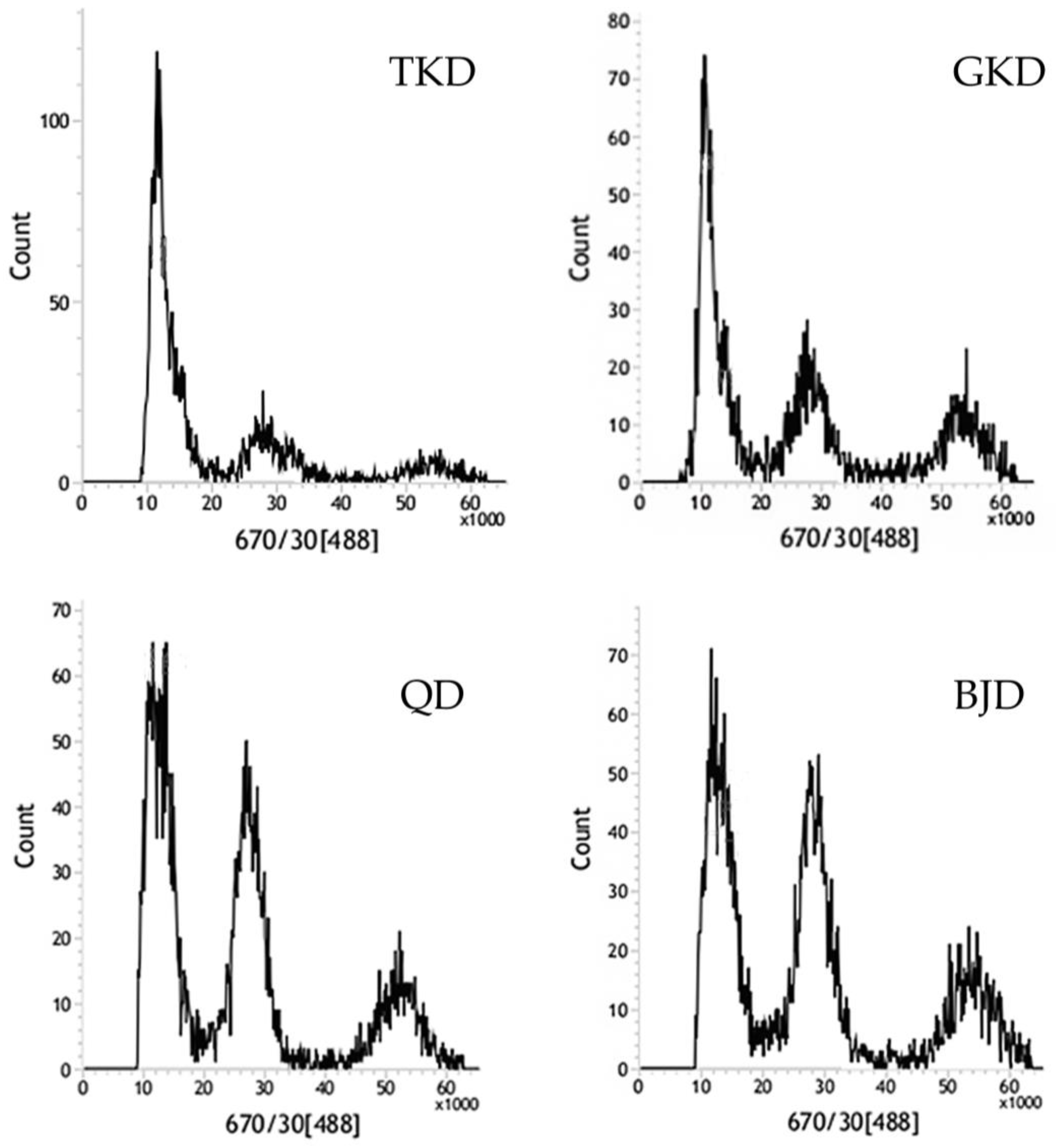

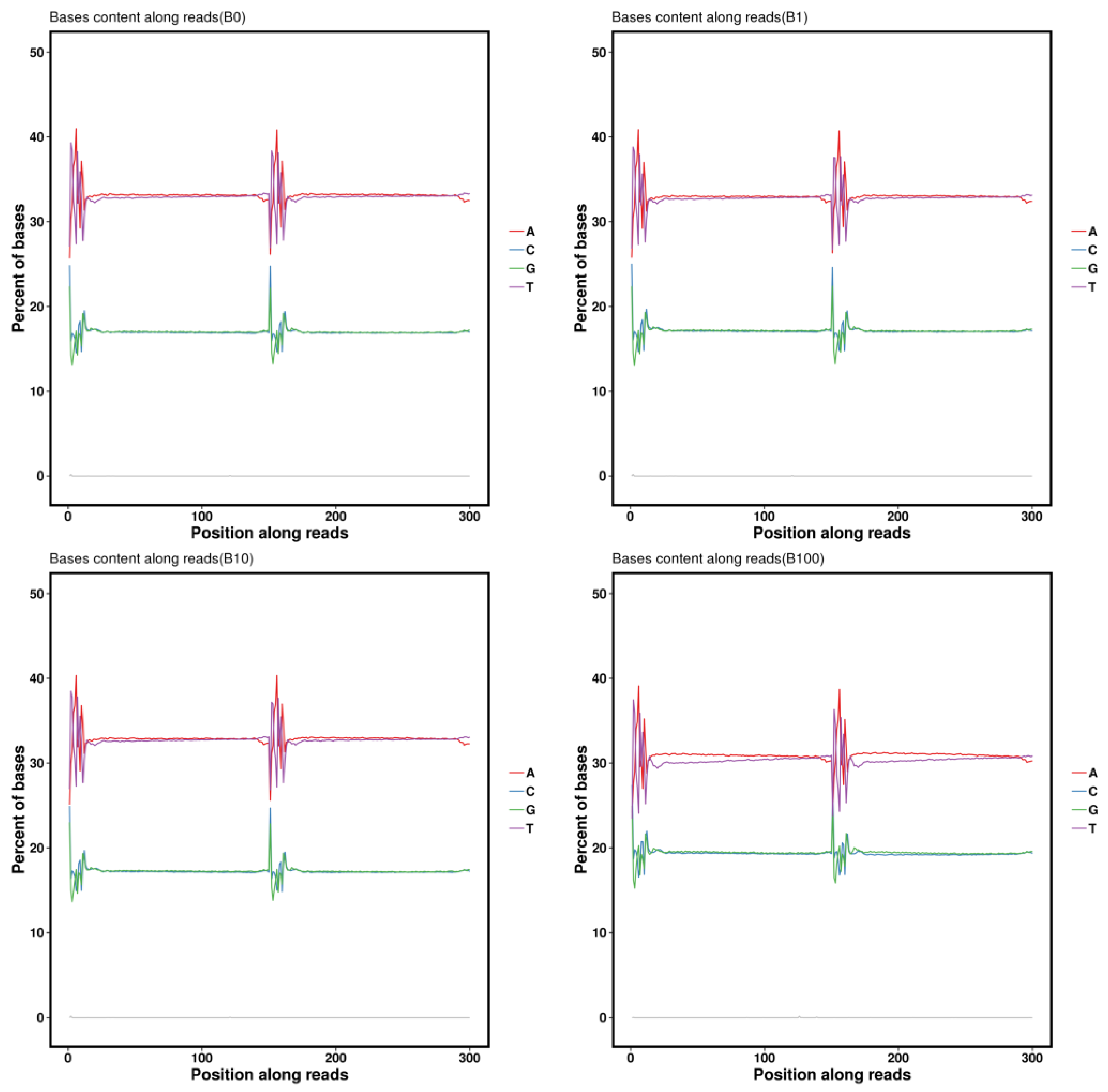
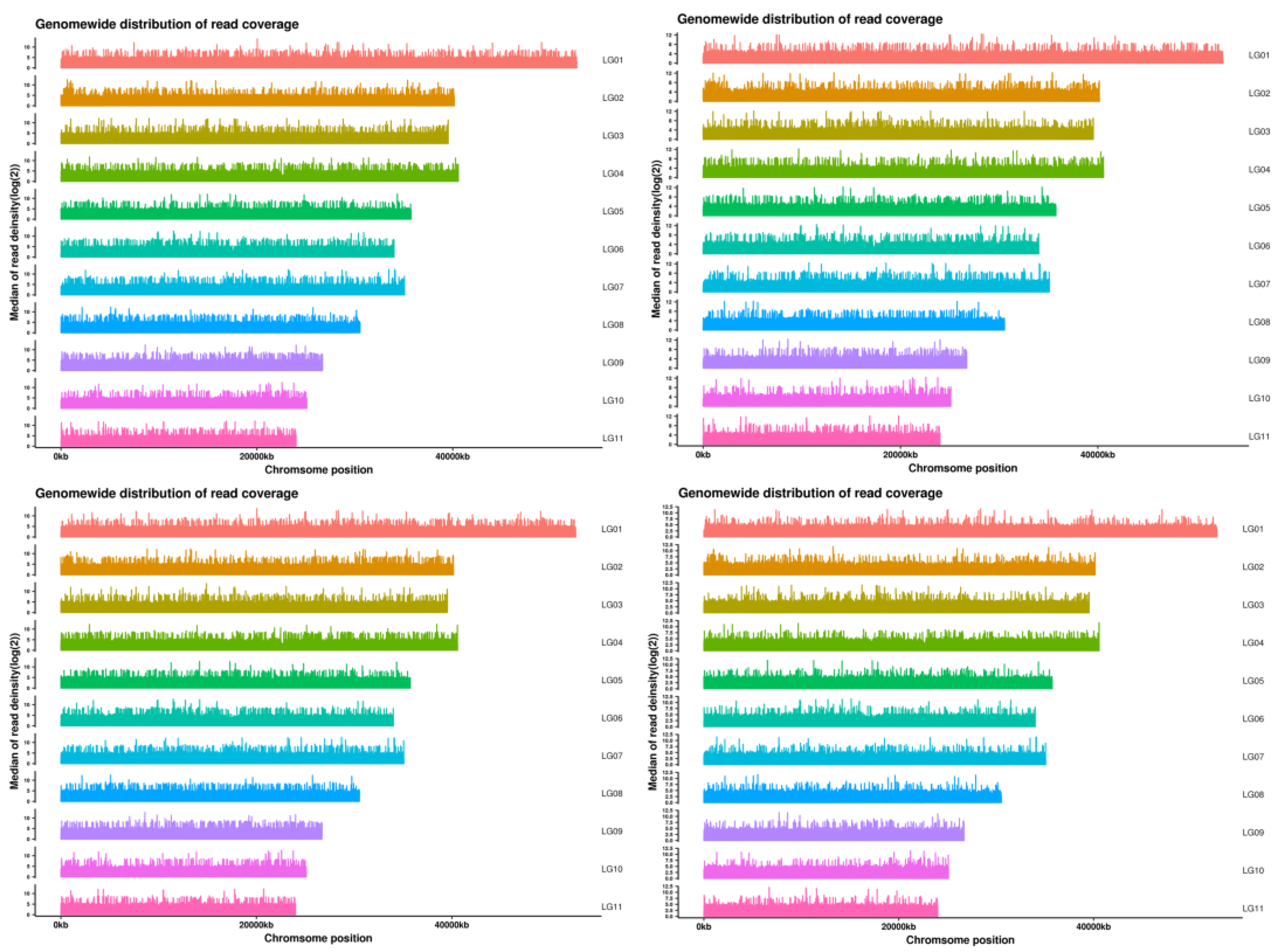

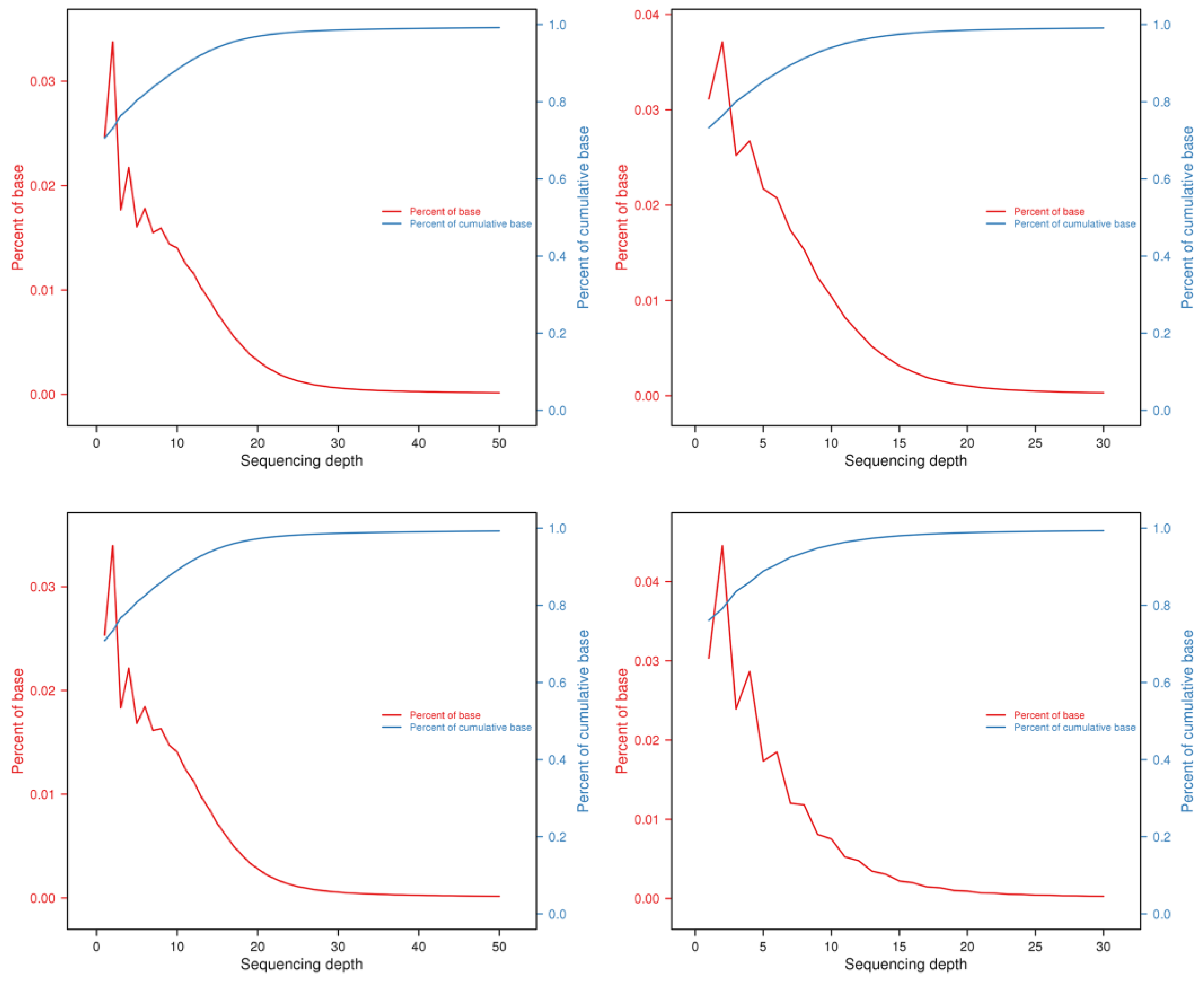

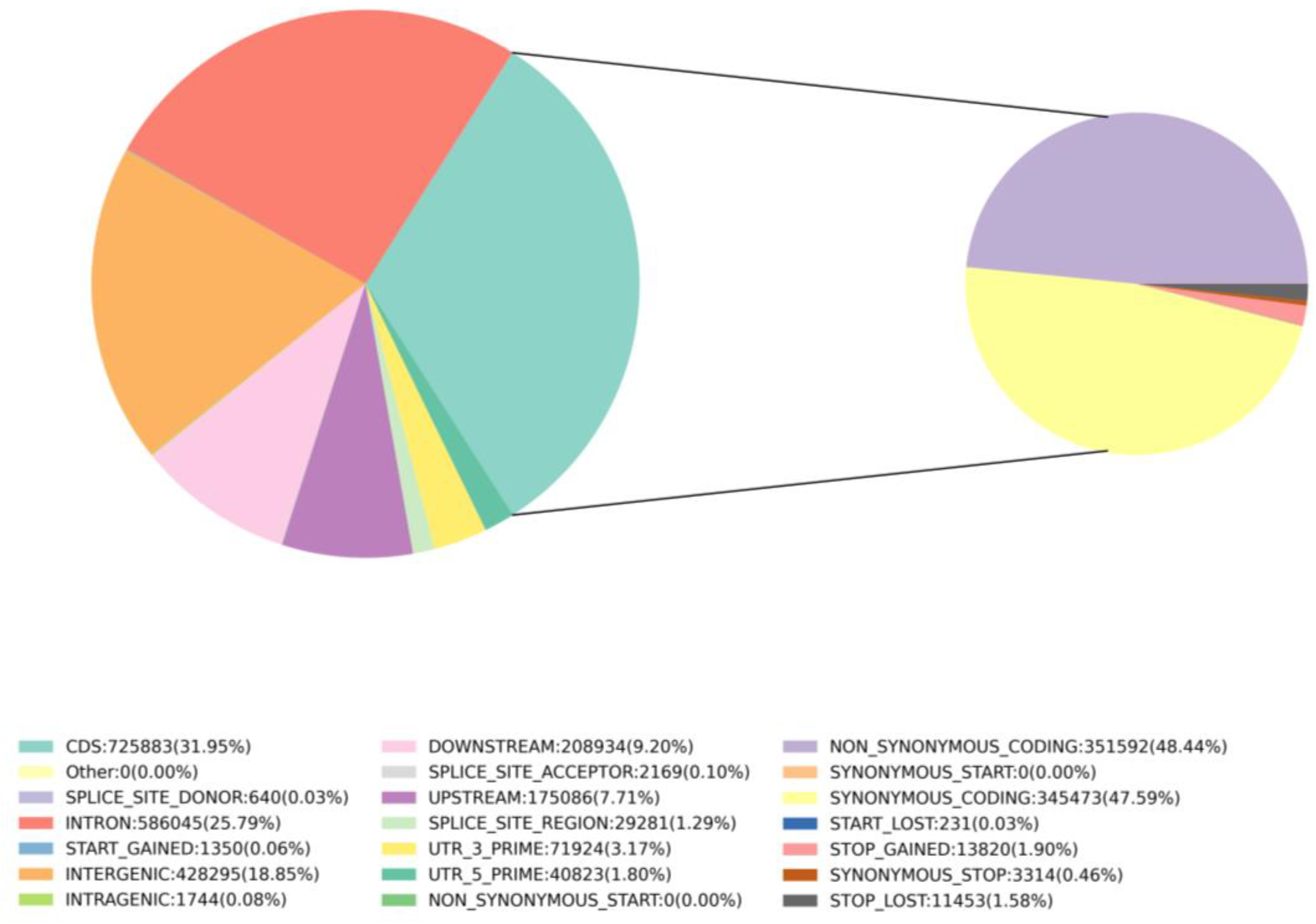
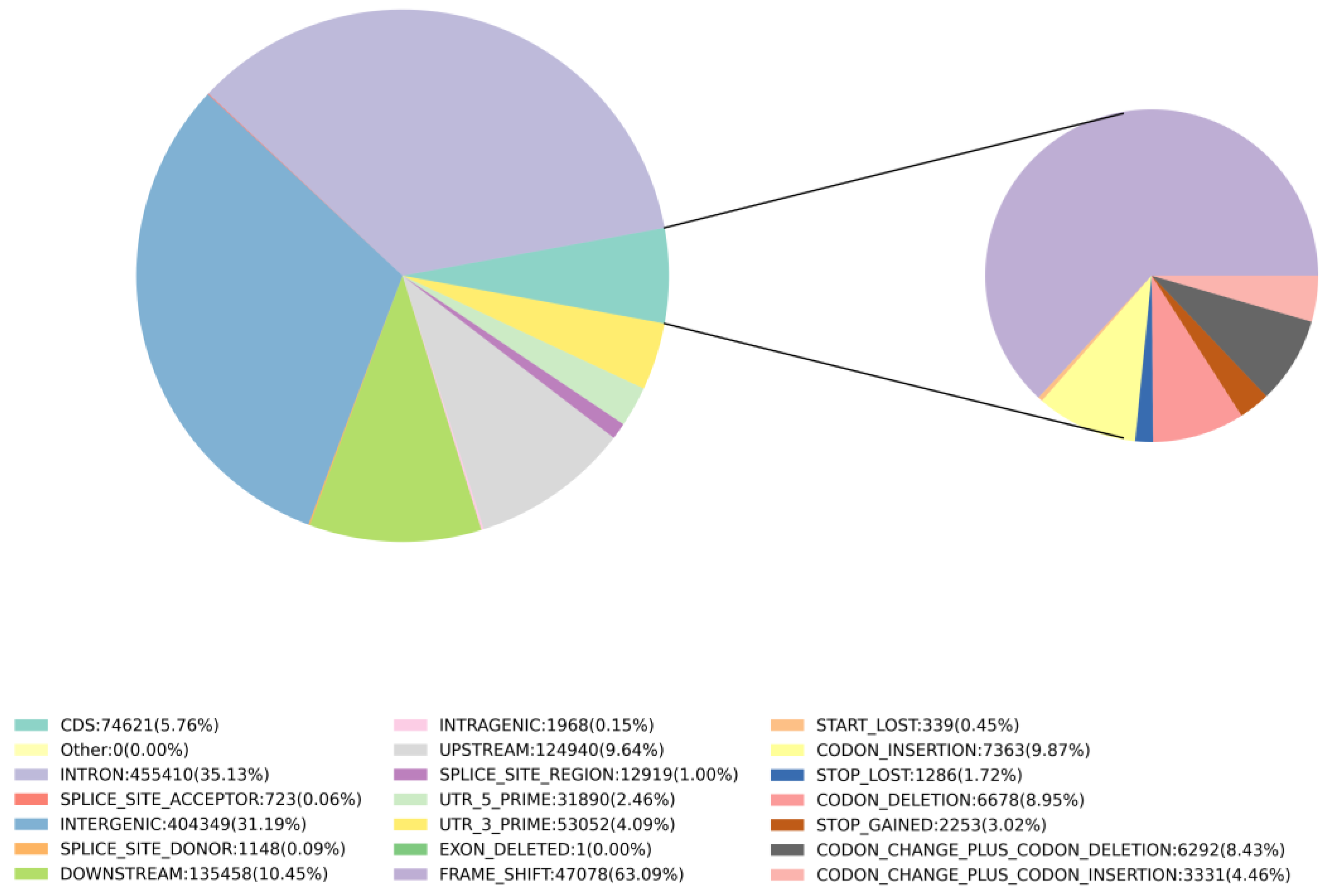
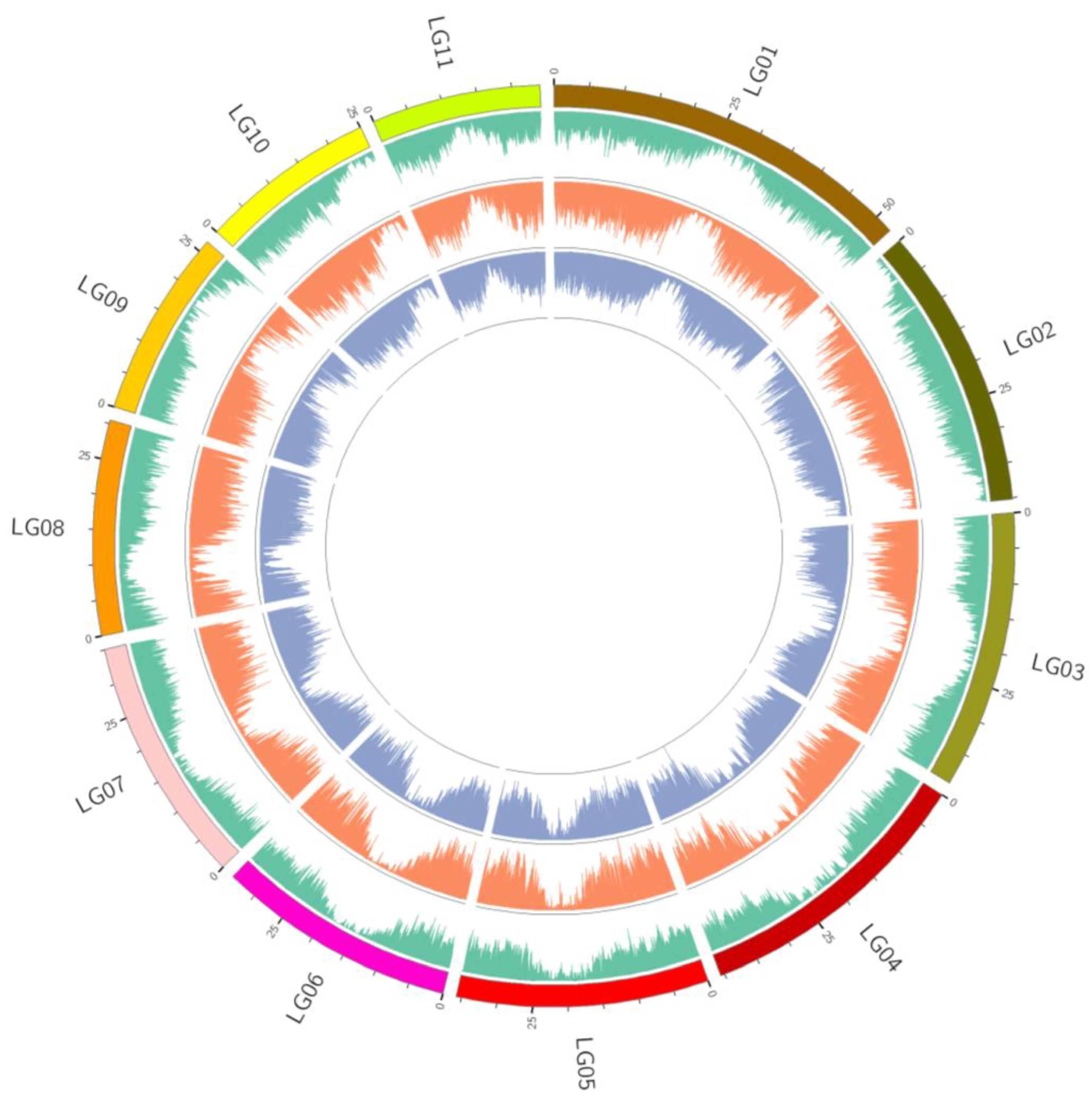
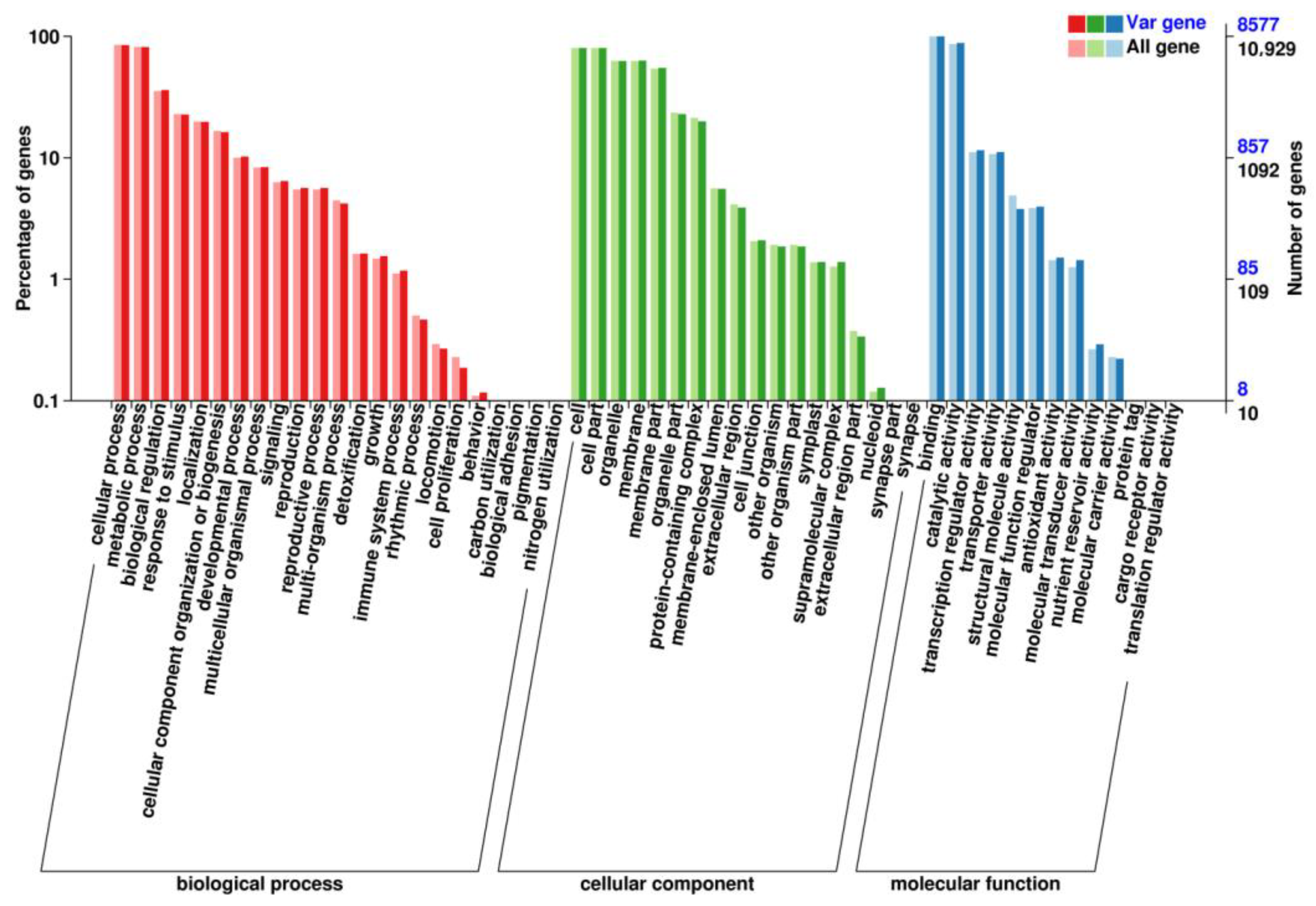
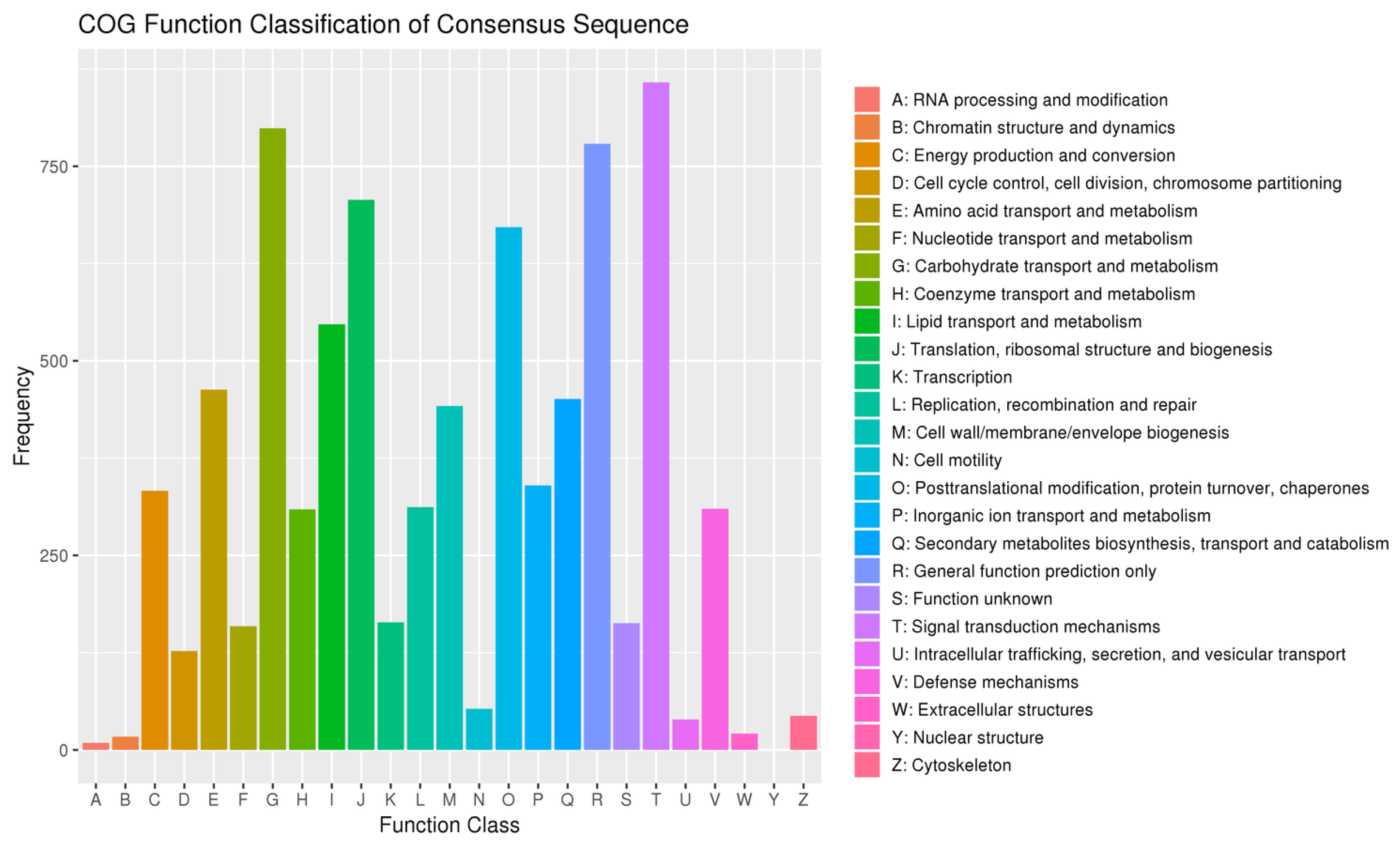
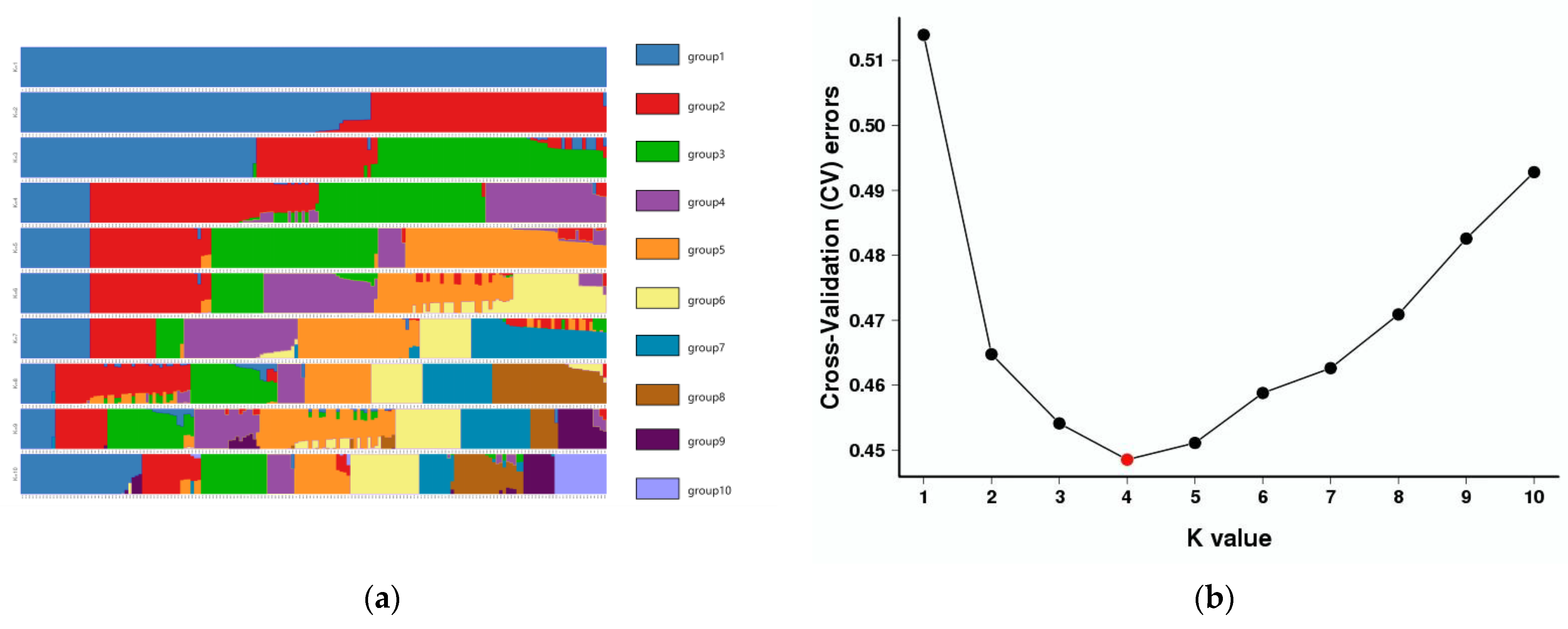
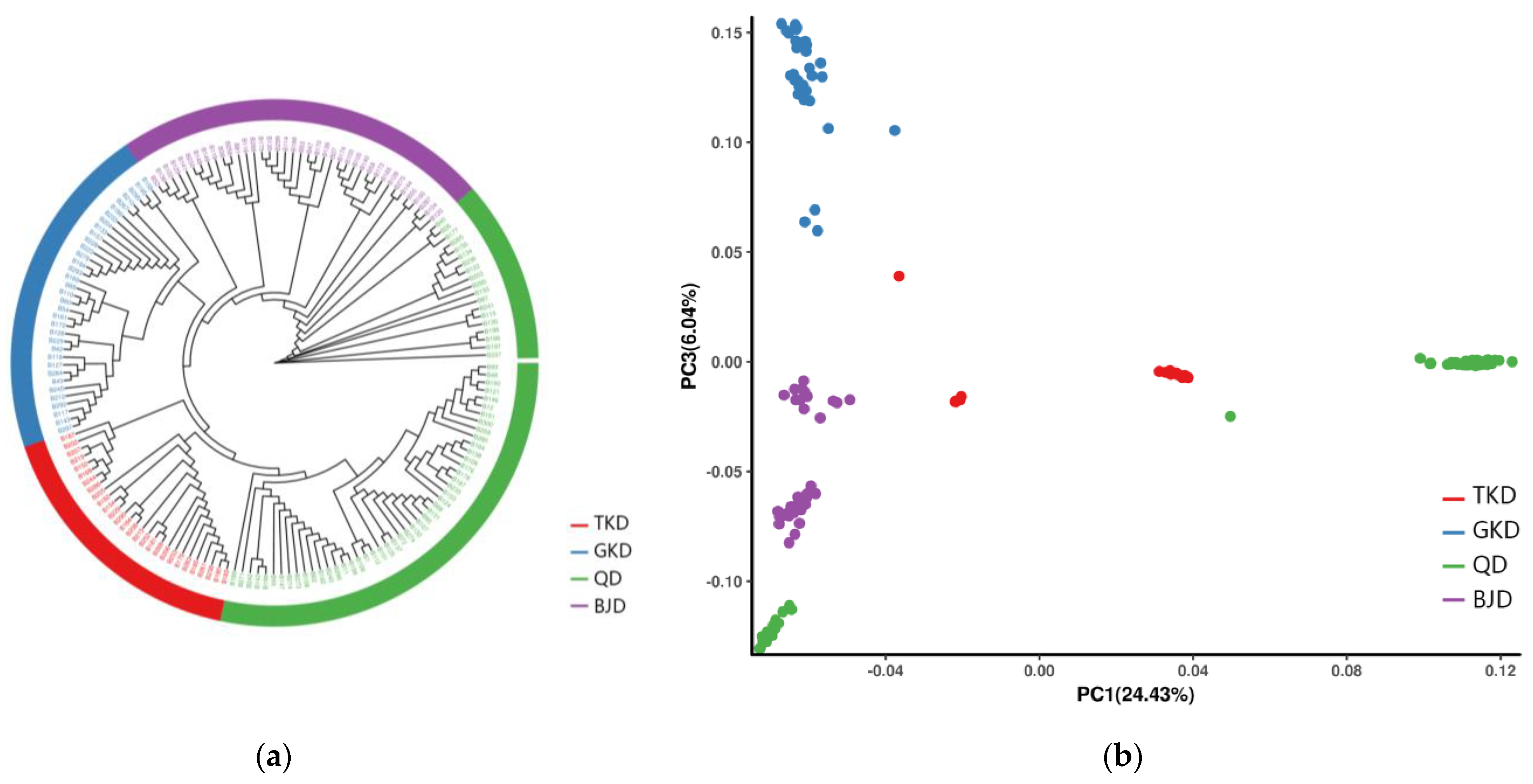
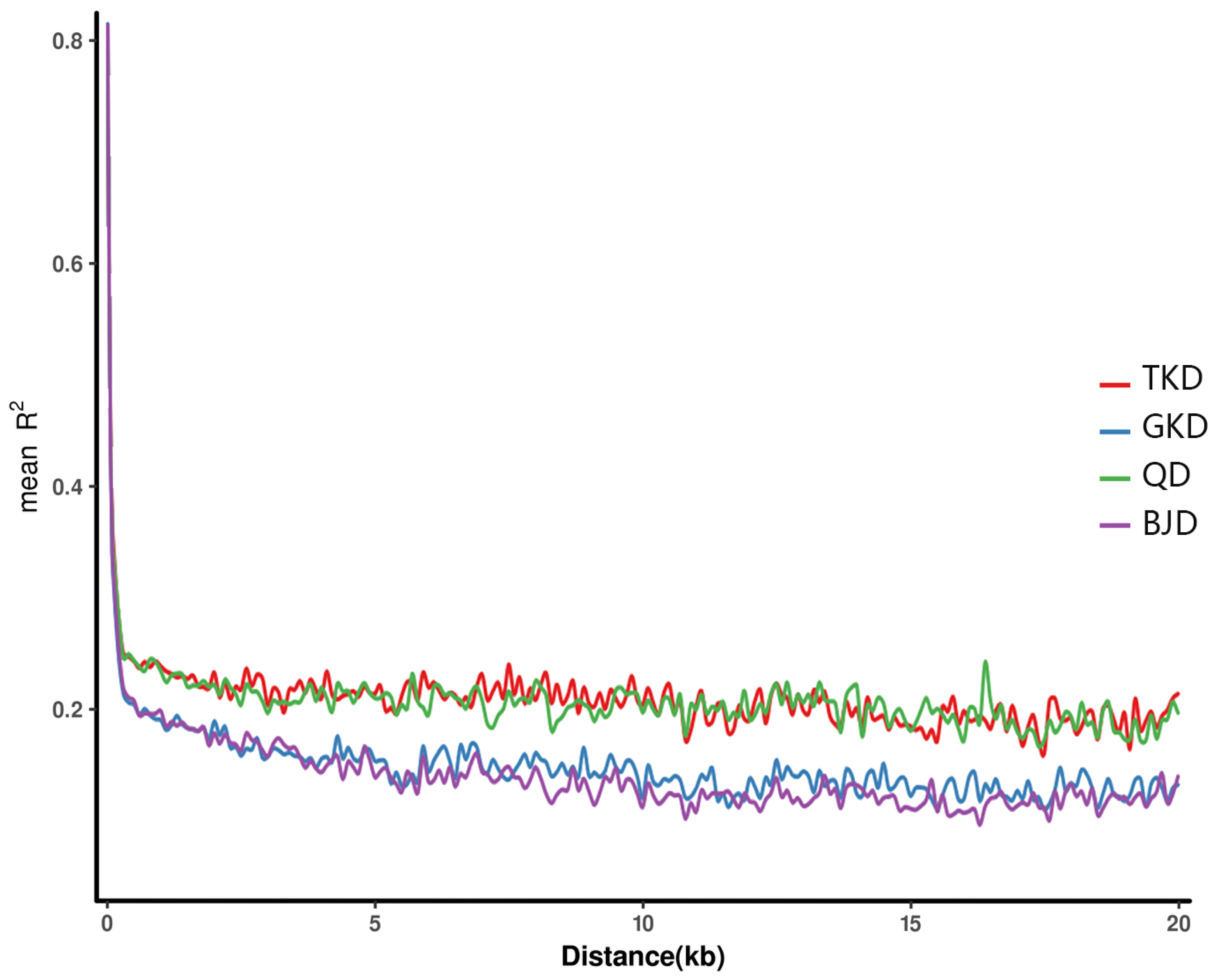
| Area | Pop | Latitude | Longitude | Amount |
|---|---|---|---|---|
| TKD | a1 | 80.912446 | 41.430356 | 8 |
| a2 | 77.35496 | 37.60674 | 13 | |
| a3 | 77.67286 | 37.79617 | 3 | |
| a4 | 78.256189 | 37.509027 | 4 | |
| GTD | b1 | 88.797772 | 44.94489 | 12 |
| b2 | 89.472407 | 44.771408 | 7 | |
| b3 | 89.972732 | 44.607383 | 5 | |
| b4 | 83.328662 | 44.574587 | 11 | |
| QD | c1 | 97.233058 | 37.124617 | 6 |
| c2 | 95.60336 | 37.458975 | 11 | |
| c3 | 97.334042 | 37.141595 | 15 | |
| c4 | 95.377427 | 37.572502 | 8 | |
| c5 | 95.287567 | 37.88953 | 10 | |
| c6 | 91.039958 | 38.098013 | 14 | |
| BJD | d1 | 100.559867 | 39.710435 | 5 |
| d2 | 100.802402 | 39.587463 | 9 | |
| d3 | 98.796332 | 39.895022 | 3 | |
| d4 | 101.515437 | 39.19226 | 3 | |
| d5 | 103.137744 | 41.685669 | 17 | |
| d6 | 102.925948 | 38.442503 | 10 |
| Group | MAF | Ae | He | Nei | Poly Marker | Ao | Ho | PIC | I |
|---|---|---|---|---|---|---|---|---|---|
| TKD | 0.27 | 1.000–2.000 | 0.035–0.500 | 0.036–0.533 | 45,656 | 1.000–2.000 | 0.036–1.000 | 0.034–0.375 | 0.090–0.693 |
| (1.441) | (0.353) | (0.360) | (1.718) | (0.414) | (0.280) | (0.523) | |||
| GTD | 0.25 | 1.000–2.000 | 0.028–0.500 | 0.029–0.517 | 42,241 | 1.000–2.000 | 0.029–1.000 | 0.028–0.375 | 0.075–0.693 |
| (1.370) | (0.318) | (0.323) | (1.664) | (0.388) | (0.253) | (0.476) | |||
| QD | 0.28 | 1.000–2.000 | 0.015–0.500 | 0.015–0.507 | 50,167 | 1.000–2.000 | 0.015–1.000 | 0.015–0.375 | 0.044–0.693 |
| (1.500) | (0.365) | (0.368) | (1.789) | (0.362) | (0.290) | (0.540) | |||
| BJD | 0.26 | 1.000–2.000 | 0.025–0.500 | 0.026–0.516 | 41,169 | 1.000–2.000 | 0.026–1.000 | 0.025–0.375 | 0.069–0.69 |
| (1.375) | (0.333) | (0.337) | (1.647) | (0.404) | (0.265) | (0.498) |
Disclaimer/Publisher’s Note: The statements, opinions and data contained in all publications are solely those of the individual author(s) and contributor(s) and not of MDPI and/or the editor(s). MDPI and/or the editor(s) disclaim responsibility for any injury to people or property resulting from any ideas, methods, instructions or products referred to in the content. |
© 2023 by the authors. Licensee MDPI, Basel, Switzerland. This article is an open access article distributed under the terms and conditions of the Creative Commons Attribution (CC BY) license (https://creativecommons.org/licenses/by/4.0/).
Share and Cite
Wei, M.; Liu, J.; Wang, S.; Wang, X.; Liu, H.; Ma, Q.; Wang, J.; Shi, W. Genetic Diversity and Phylogenetic Analysis of Zygophyllum loczyi in Northwest China’s Deserts Based on the Resequencing of the Genome. Genes 2023, 14, 2152. https://doi.org/10.3390/genes14122152
Wei M, Liu J, Wang S, Wang X, Liu H, Ma Q, Wang J, Shi W. Genetic Diversity and Phylogenetic Analysis of Zygophyllum loczyi in Northwest China’s Deserts Based on the Resequencing of the Genome. Genes. 2023; 14(12):2152. https://doi.org/10.3390/genes14122152
Chicago/Turabian StyleWei, Mengmeng, Jingdian Liu, Suoming Wang, Xiyong Wang, Haisuang Liu, Qing Ma, Jiancheng Wang, and Wei Shi. 2023. "Genetic Diversity and Phylogenetic Analysis of Zygophyllum loczyi in Northwest China’s Deserts Based on the Resequencing of the Genome" Genes 14, no. 12: 2152. https://doi.org/10.3390/genes14122152





